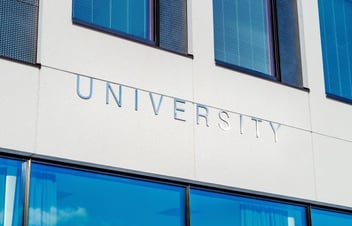How to Compare Financial Aid Award Letters
.png)
For most people who go to college, financial factors are EXTREMELY important - many folks will choose their college based on the financial aid package. Because they’re not all the same - there are a lot of numbers and a lot of factors to consider - it’s easy to get overwhelmed by all the different letters! Here are four sample financial aid letters broken down to help you understand how to take yours apart!
Some financial aid letter vocabulary:
- 100% need-met schools: These schools meet all the need that the federal government defines that you have. These are usually highly selective private schools - see the schools at the top of US News University Rankings and US News Liberal Arts Colleges - with large endowments (which is how they can afford to meet 100% of need).
- No-loan schools: These schools meet 100% of need AND will offer you a financial aid package that doesn’t include loans - so you graduate debt-free! Here’s a list of no-loan colleges from US News
- Grants and scholarships are free money; they do not need to be paid back. You want as much of your financial aid to come from grants and scholarships as possible, as this will reduce your debt burden after you graduate.
- Loans are money that will need to be paid back. When you get a loan, find out:
- What the interest rate is - what percentage of the value of the loan you’ll have to pay
- Eg. A loan that has a 27% interest rate is probably too high to take out
- Eg. A loan that has a 27% interest rate is probably too high to take out
- What the term of the loan is - by when you’ll have to pay it back
- Eg. A $40K loan that has to be paid back within 5 years is probably too short a term to be able to pay it back.
- What the monthly loan payments will be
- Eg. A monthly loan payment of $10,000 is probably too high
- What the interest rate is - what percentage of the value of the loan you’ll have to pay
- Federal loans/subsidized vs unsubsidized: Both are federal loans that total (when given together) $5,500. $5,500 per year is the maximum that most college access people tell you it’s safe to borrow.
- Federal loans are the safest to take out/say yes to because
- The interest rate can’t change (it’s fixed), which is not always true of private loans
- The interest rate is usually lower than private loans’ interest rates
- Subsidized means that interest doesn’t start accruing until 6-9 months after you graduate from college
- Unsubsidized means that interest starts accruing immediately after you take it out
- MAKE SURE YOU compute your payment schedule and your total interest paid over the life of the loan before you say yes.
- Federal loans are the safest to take out/say yes to because
- FAFSA = Free Application for Federal Student Aid - you’ll have to fill this out during senior year. The FAFSA application opens October 1 of every year; apply on October 1 to get the best aid, as the money runs out (it’s not infinite!). There’s usually someone at your school or local library who will sit with you to fill out the FAFSA; you’ll need a copy of your most recent income tax returns.
- EFC (Expected Family Contribution) - that’s how much the government thinks you and your family can afford to pay for school, which determines how much aid you can get from the college.
- Net price calculator - pre-calculation of how much the government thinks you/your family can pay for college. Google the school name and “net price calculator” to find the one for each school. You can cross-compare schools; those which meet 100% of financial need will give you the same aid, but those that don’t meet 100% of financial need will give you different aid amounts depending on their different policies.
- Loans can be declined — if you’re only being offered loans whose interest rate you dislike and if you can get better interest rates somewhere else/if you can afford to pay without loans, you can opt not to take them.
- Most schools use an online portal that allows students to fully accept/decline/accept a smaller portion of a loan.
- Public vs private schools: Private schools cost more than public, but often have more aid to give. Highly selective private colleges will meet 100% of financial need, so they’re actually CHEAPER!
Full Ride Financial Aid Letter - college on trimester system that meets 100% of financial need
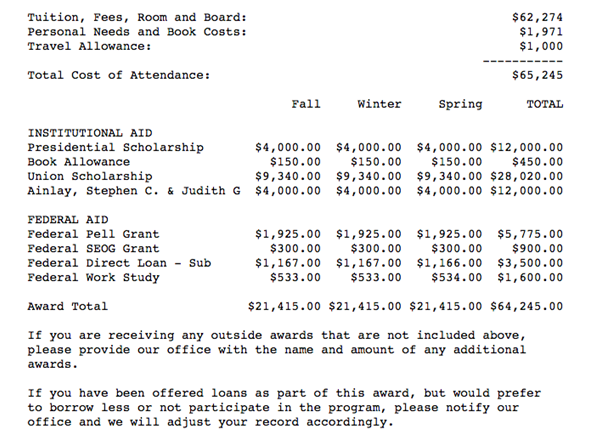
- Total cost of attendance = the whole price, all together: $65,245. Remember that not all colleges include room and board in this number and double-check that that’s included if you’re planning to live on campus.
- Gabbie got an allowance for books and travel — not all colleges will give this generously!
- But Gabbie lives in Florida, so $1,000 is probably not a realistic amount for her to go home/back 4 times/year minimum (to school, winter break, back to school, home for the summer).
Institutional Aid = Money from the College
- All grants and scholarships are money you don’t have to pay back - we like these in the “Institutional Aid” section.
- Because they come from the college, it’s likely that Gabbie was awarded these as part of this college’s commitment to meet 100% of need. It is also possible that there are requirements to keep the scholarship, like maintaining a certain GPA. Gabbie will have to find out if there are requirements and, if so, make sure to maintain them - her aid will depend on it!
Federal Aid = Money from the Federal government
- Pell Grants come from the federal government and are based on income; you are automatically issued one based on income that you enter on the FAFSA. Grants are free money; no need to repay.
- There are strict penalties for falsifying information on the FAFSA, and I’ve heard that they check about 1 out of 5 of all applicants’ FAFSAs - so make sure you tell the truth!
- The SEOG (Supplemental Educational Opportunity Grant) is based on the FAFSA qualifications. No need to repay; you are automatically , does not need to be repaid, and again, is automatically applied for based on your FAFSA.
- The Federal Subsidized loan DOES need to be repaid; you’ll accrue no interest until 6-9 months after you graduate.
- Work study = on-campus job. The number listed is the maximum amount the college can pay you based on what they have been allotted - so you still have to find a job on campus and work the hours to get paid that money. Often the on-campus job has more money than is listed on your financial aid letter and you can continue working to make a little extra money if you want to - but these jobs pay $7-15/hour, so don’t expect to make a tremendous amount.
- Don't work more than 10-12 hours/week while a full-time college student. You need to study in order to do well, and if you graduate with a low GPA and don’t know the things you are supposed to, you’ll have trouble getting hired and will get quickly fired. Your job is to learn for the time you’re in college; devote yourself to that as you would to a job.
Big Takeaways - Full Ride Financial Aid Letter
- She will owe $1,000/year according to this package. It doesn’t say that anywhere on the letter - that’s math that you have to do yourself.
- Gabbie can negotiate! Maybe she can’t pay 1K/year - she can ask the office of financial aid for more, which they may/may not have.
- How much money can I borrow from the government? (from studentaid.gov, a US government website) https://studentaid.gov/help-center/answers/article/how-much-money-can-i-borrow-federal-student-loans
Partial Aid Letter - Alfred University
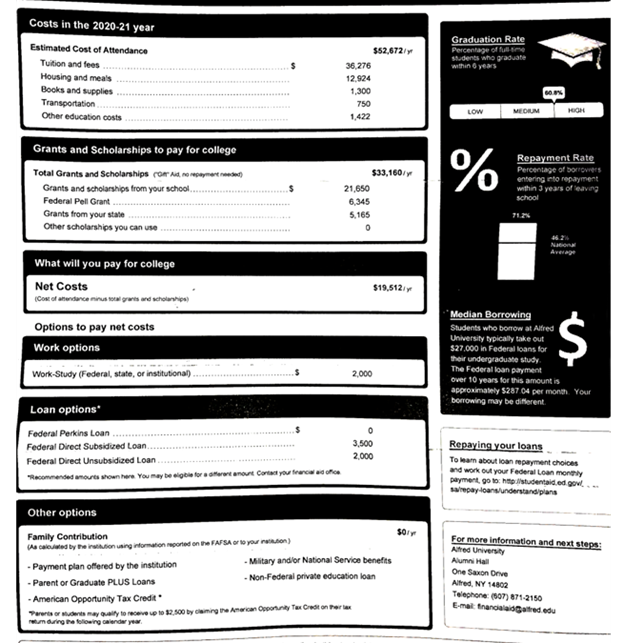
What You Will Pay for College
- They’ve subtracted the “Estimated Cost of Attendance” and the “Grants and Scholarships” to give you your net cost - and yes this includes room and board - great!
Options to Pay Net Costs
- This letter is done a little differently - it lists options but makes no assumption that you will use them:
- Work Study
- Loans (the $5,500 from the federal government)
- EFC - this school acknowledges that Miguel’s EFC is $0 (his family can’t afford to help with college), but that doesn’t mean they meet 100% of need, unfortunately
- Note that the college doesn’t show Miguel how to pay the whole bill - they list some vague options, but from this letter, there’s no way to pay for the whole thing!
Big Takeaways
- If he takes the work study and the loans, his annual payment will be $19,512 - (2000+3500+2000) = $12,012. This number - $12K - appears nowhere on the letter. That’s math you have to do.
Partial Aid Letter - Mercy College
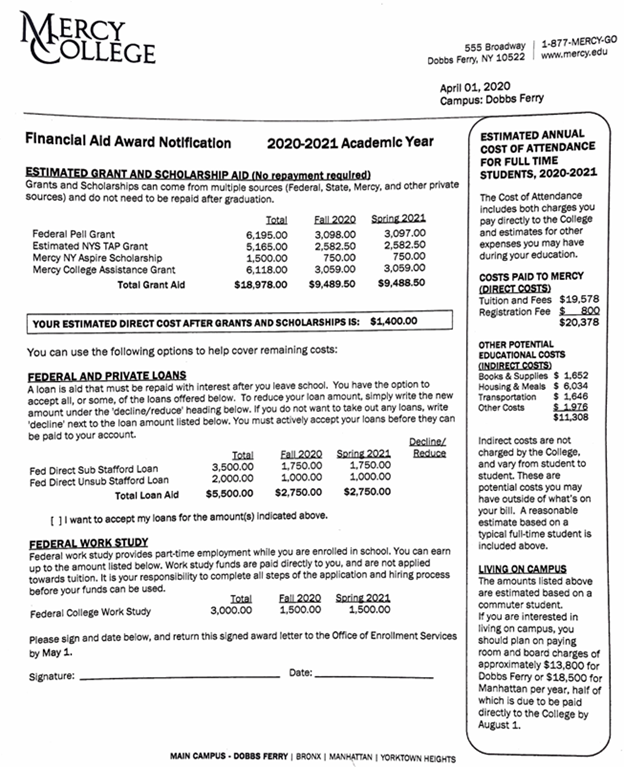
Estimated Grant and Scholarship Aid
- This has the estimated direct cost after grants and scholarships, which seems like a great price – $1,400!
- But don’t forget the sidebar - they are not including room and board.
- NOTE: The numbers they list as room and board are not what THEY charge, but what they estimate a commuter student should budget. So assuming Miguel wants to live on campus in Dobbs Ferry, there’s another 13.8K that Miguel now has to add to the other listed expenses - which totals to $19,704.
- The $19,704 cost of room, board, books, and more is added to this “estimated direct cost” of $1,400 – his final cost to attend and live on campus is $20,474.
Federal and Private Loans/Work Study
- You can see Miguel’s subsidized and unsubsidized loans
- Miguel was also offered work study
- Accepting these loans and doing work study would decrease his total cost to $11,974
Big Takeaways
- Nowhere in this letter did they do any of the math that Miguel really needed to understand what he was going to PAY!
- They hid the cost of room and board on campus - what looked like a great deal ($1,400) actually ended up being 10 times that ($11,974)! DOING THE MATH IS ESSENTIAL!
No Loans, Full Ride - Swarthmore College
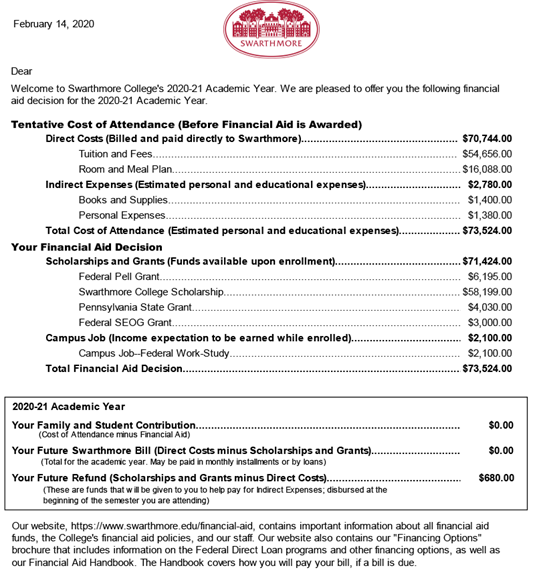
Tentative Cost of Attendance
- The school lists room and board right up front, as well as books and personal expenses, so Malik knows that everything he needs to worry about has been covered.
- You’ll notice this price tag is extremely high - many families get scared off from the high sticker price of private colleges - but they also have the most $$ to give financial aid.
Your Financial Aid Decision
- Everything that’s on here is money that Malik DOES NOT have to pay back - all grants and scholarships!!!
- The only thing Malik is really responsible for is work study, which means he’ll have to get an on-campus job.
Big Takeaways
- This student will have NO MONEY to pay back after college - “no loan” schools have committed to give students financial aid that will not leave them in debt.
- This student will actually get money at the end, to the tune of $680, in order to help pay the indirect expenses Swarthmore may not have accounted for - because they know things come up!
Financial aid letters run the gamut: Your best bet in navigating them is to ensure you’ve identified:
- Is room and board included in the outlay of costs?
- Are there other specific costs that are specific to your family that you need to make sure you’ve accounted for?
- We strongly suggest you only say yes to $5,500/year in loans (take the federal loans!)
- Make sure you’ve subtracted the cost minus whatever free money and loans you’re going to take.
- You can advocate for more money if you need it - call the financial aid office. There’s often wiggle room - depending on the school, it can be $1-5K.
- If you have questions about the financial aid decision, you can always ask the financial aid office at the school - that’s their job.
- If you’re worried about divulging your identity (eg. you’re undocumented), you can always call and ask a hypothetical question or have a college access person call for you.
- Working with someone with experience in financial aid is ESSENTIAL. These folks can help you make sure you don’t miss anything and fully understand what you’re agreeing to.
Alyssa is the Co-Founder and Executive Director of the Yleana Leadership Foundation, which operates Socratic Summer Academy/SSA Online College Prep. She is a college readiness/admissions expert, known on YouTube as Alyssa the College Expert.




